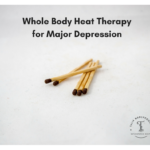 Since publising the original article about the Mirena IUD on this blog, thousands of women have come out of the woodwork writing to me asking for help.
Since publising the original article about the Mirena IUD on this blog, thousands of women have come out of the woodwork writing to me asking for help.
When I originally wrote the article, I was spurned on by my observations of the women in my practice who had experienced a rise in estrogen dominance and low progesterone after the insertion of their IUDs (which were often inserted to treat hormone imbalances!).
At that point I never imagined that so many women would be affected by the IUD, or that even more were suffering from so many hormonal symptoms that drastically affected their lives and health.
It makes sense: our society does not set us up for proper hormonal function.
Our diets are carbohydrate-heavy, promoting insulin resistance and blood sugar dysregulation, which impacts our ovaries’ ability to make estrogen properly.
An excess amount of body fat produces more estrogen in the body and acts as a reservoir for the toxic estrogens in our environment.
We lack many of the micronutrients necessary to process our hormones properly, such as vitamin D, B vitamins, magnesium, zinc, omega 3 fatty acids, glutathione, and amino acids.
Many of us have impaired or suboptimal liver function, or sluggish digestion, which keeps hormones in our bodies around longer than they should be.
A dysbiotic gut has the tendency to turn estrogen in the gut back “on”, putting it back into circulation when it was otherwise on its way out of the body.
Stress alters our hormonal function, including our ability to make progesterone, DHEA-S, convert thyroid hormones, and process estrogen properly.
Xenoestrogens in our food and environment, from plastics, fragrances, pesticides, and processed soy products, contribute to overall body burden of the hormones in our body, throwing off our delicate balance, and contributing to symptoms.
The result of all this is that many women suffer from hormonal imbalances.
10% of women have some form of PCOS, or Polycystic Ovarian Syndrome, characterized by the body’s inability to properly make progesterone or estrogen, instead making loads of male hormones, like testosterone. PCOS alters fertility, promotes weight gain, and causes things like unwanted facial hair growth, acne, and missed periods. PCOS is often connected to stress and insulin resistance.
Many women in my practice suffer from PMS or PMDD, experiencing often debilitating symptoms sometimes even two weeks before their periods begin. They might get migraines, intense cravings for sugar, and massive mood changes, such as anxiety, intense irritability, or devastating depression. Panic attacks can occur at this time as well. Many of them comment that their mood and personalities flip once their hormones levels reach a certain point, causing them to act like different people. This can jeopardize their relationships with spouses and children, coworkers, friends and family.
Tender and painful breasts, or breast lumps, are also common in many of these women.
Acne, weight gain, stress, fatigue, disrupted sleep, depression and anxiety are all symptoms I see in women with hormonal imbalances.
Many women have horrific cycles, experiencing painful and heavy periods that often cause them to miss days of work every month. Many of these women struggle to keep their iron levels in the optimal range, suffering from hair loss, fatigue and weakness.
Many women are diagnosed with fibroids, or endometriosis, or are concerned about their risk of female cancers like breast, ovarian, uterine and cervical cancer.
All of these symptoms are often linked to relatively higher levels of estrogens compared to progesterone, sometimes termed Estrogen Dominance by functional medical practitioners who look at the underlying causes of bodily imbalances.
I feel terrible that I can’t help more of the women who write to me. My license prevents me from giving advice to those who live abroad, especially to non-patients over the internet. It’s a shame, however, because oftentimes the solutions are relatively simple, despite how complicated many of these symptoms might seem.
I’m hoping that this article can provide some direction to many of the women who suffer.
Firstly, I want to state that I am not against birth control or even the Mirena IUD (or other IUDs, for that matter). The vast majority of women with the IUD tolerate it. For many women with debilitating heavy periods and endometriosis it can be the only viable solution that makes life tolerable.
In my social practice at Evergreen, many of the women I see experiencing homelessness, drug addiction, or PTSD from relationship trauma, rely on the efficacy of IUDs to prevent unwanted pregnancies. Their lives often don’t allow for them to remember to consistently take pills every month.
Many women don’t tolerate combination birth control because of a history of blood clots, female cancers, or migraine headaches associated with their periods, and therefore the Mirena IUD, which is progesterone only, is a safe alternative for preventing unwanted pregnancy.
That all being said, many women do suffer on the Mirena IUD (or other forms of birth control). They were perhaps put on the Mirena to deal with some of the above symptoms of hormonal imbalance, or for contraception. Many of them noticed that their symptoms became worse after insertion of the IUD.
How the Mirena IUD and Birth Control Works:
The Mirena works by secreting small amounts of progestins, a synthetic form of progesterone, into the uterus and surrounding tissues. While it is not fully known how the Mirena works, the end result is a suppression of ovulation. This results in either very light periods or a complete cessation of periods until the IUD is removed (after 5 years when its hormones run out).
It is important to say here that, while birth control can certainly treat the symptoms of hormonal imbalances, it does not correct them.
All forms of birth control, with their synthetic versions of the hormones estrogen and progesterone, simply induce further hormone imbalances in the body. They introduce versions of hormones that may suppress or alter symptoms (such as heavy and painful bleeding, or acne), but the versions of hormones are not fully recognized by the body and therefore don’t fully replace all the hormones’ important functions, such as mood regulation, immunity, or blood sugar balance.
The effects of both altering the body’s natural hormonal balance, while ignoring the underlying cause of hormonal issues, is often what causes symptoms to continue or worsen.
For example, women with PCOS are prescribed birth control to manage acne or promote monthly periods. However, when women with PCOS miss periods, it is because they are not ovulating. The missed periods are not the problem; the lack of ovulation is.
Despite that, many women with PCOS experiencing amenorrhea (or missed cycles) will be prescribed birth control. However, birth control does not address the underlying cause of amenorrhea. It simply further suppresses ovulation (because its main purpose is to prevent unwanted pregnancy).
The periods you get while on birth control are not periods. Periods from birth control are withdrawal bleeds. After 21 days of taking hormonal pills, pills are stopped or replaced with placebo pills. The withdrawal of hormones in the pills induces a bleed that resembles a period, but is not one.
Hormonal contraception does not correct hormonal imbalance, it imposes further hormonal imbalance to manage symptoms. This is not always bad!
But it is an important difference.
Many women do require symptom suppression, particularly if their symptoms are severe. Many individuals in my practice experience periods so heavy that the only way for them to get through the month is with an IUD. Genetic variability in how our bodies process hormones can make us susceptible to intense hormonal symptoms, through no fault of our own.
In my opinion, however, it is important to attempt to address the underlying cause and to set our bodies up for better hormonal regulation, making as many changes as our lifestyles will allow.
What You Can Do About It:
 If you are like any of the people I described above who seek my help, there are a few things that you can do to get started on correcting hormones.
If you are like any of the people I described above who seek my help, there are a few things that you can do to get started on correcting hormones.
Working With a Professional:
The first thing I advise is finding a licensed naturopathic doctor or functional medicine practitioner who understands hormones, can order lab tests, and will address the underlying cause of your hormonal imbalances by taking the time to fully understand your body and lifestyle.
This practitioner might be a naturopathic doctor (you can find one in North America by looking one up at naturopathic.org), or a medical doctor, a chiropractor, or a highly skilled nutritionist or nurse practitioner. Research this person well, read their articles, and perhaps book in with them for a complimentary meet and greet.
Testing:
I often test patients using simple blood tests, on day 21 of their cycles (or about 7-9 days before they expect their next period).
I will test their blood, looking for anemia, will test iron and B12 levels, homocysteine (to gauge their ability to methylate), vitamin D, cholesterol (to see if their diets are promoting proper hormone synthesis), estradiol, estrone (the more toxic, problematic estrogen), progesterone, free testosterone, a thyroid panel, fasting glucose and fasting insulin (to calculate insulin resistance using something called the HOMA-IR), HbA1C (to look a long-term blood glucose control), FSH and LH (two hormones made in the brain that talk to the ovaries and orchestrate the menstrual cycle), DHEA-S, to name a few.
Some women will require more testing. Others will require less.
These labs are interpreted from a functional perspective. Even though you are in the “normal” ranges (which take into account the entire population, many of which are not healthy—they are seeing their doctors, after all!), these blood markers may not be optimally balanced, giving us an opportunity to correct things before they go further.
Testing allows us to match symptoms to underlying imbalances and to be able to properly direct treatment protocols. Women with estrogen dominance may be experiencing high levels of estrogen and normal progesterone, which indicates a body burden of estrogen or impaired liver and digestive system clearance. Other women may be experiencing normal levels of estrogen but low progesterone, indicating a failure of their bodies to ovulate, due to high stress, and PCOS (or the Mirena IUD and birth control pill).
Other options for hormonal testing are month-long salivary hormone testing, or DUTCH testing, which looks at hormone breakdown in the urine. I sometimes run these tests, but find that blood testing is useful, accurate, and more cost-effective.
Treatment:
 Once you understand your individual hormonal situation through testing (and through working with a practitioner who is putting the testing together with your symptoms and health history), your practitioner may recommend a variety of treatments.
Once you understand your individual hormonal situation through testing (and through working with a practitioner who is putting the testing together with your symptoms and health history), your practitioner may recommend a variety of treatments.
I personally combine diet and lifestyle with key herbal and nutritional supplements, to target what is going on under the surface with my particular patients.
These treatments may include herbs that boost ovulation, aid liver detoxification, or regulate the stress response. I might recommend nutraceuticals that encourage methylation, or aid in hormone production.
My treatments take into account the individual’s symptoms, labs, diet, lifestyle, and any other health issues she may be facing like fatigue, digestive disturbances, or poor sleep.
What You Can Do Today:
Barring more individualized assessment and advice, there are some best lifestyle practices that can help most women balance their hormones better, whether they are still using birth control to control and address their hormonal symptoms or prevent pregnancy.
Diet:
When it comes to diet and hormone support, we need to ensure that we are balancing blood sugar, boosting liver detoxification pathways, promoting hormone synthesis, and supporting digestion, especially if experiencing constipation.
- Consume more leafy greens: kale, spinach, collards, beet greens, arugula, etc. Eat 1-2 cups of these foods every day. Leafy greens contain active folate, which boosts methylation and detoxification. They also contain magnesium which is essential for hormonal regulation as well as 300 other important biochemical reactions in the body that balance mood and hormones.
- Consume more cruciferous vegetables: broccoli, cauliflower, brussel sprouts, cabbage, bok choy, etc. Eat 1-2 cups of these foods every day. Crucifates help the body make glutathione, and contain indole-3-carbinole, which helps eliminate excess estrogens from the body. Broccoli sprouts are potent players in these pathways. Consume them as often as possible.
- Ensure adequate dietary fibre intake: I often recommend ground flaxseeds or chia seeds in smoothies, avocados, fruits and vegetables and legumes (if tolerated) to make sure that women are having regular bowel movements to clear excess estrogens out of the body. 2 tbs of ground flaxseed (or more) every day can help balance estrogen levels and promote daily bowel movements.
- Balance blood sugar: consume protein, fat and fibre at every meal. Avoid refined starches and flours. Avoid all sugar, even natural sugar like maple syrup, coconut sugar, cane sugar, honey, agave, etc. Try stevia or avoid sweets. Limit carbs (grains, legumes, root vegetables like potatoes or sweet potatoes, to 1/2 cup to 1 cup per meal). Only consume whole grains like quinoa, buckwheat, steel cut oats, millet, and teff. Cook them yourself!
- Avoid soy, particularly processed soy, like vegan burgers, or soy milk.
- Consume omega 3 fatty acids in fatty fish like salmon and sardines, or nuts and seeds like flax and chia seeds, walnuts, and pumpkin seeds. Get 2-4 tablespoons of these nuts and seeds every day and 3-4 servings of fatty fish a week.
- Consume animal products: eggs contain choline, which is essential for liver function, meat contains vitamins B6 and B12, which are essential for hormonal regulation and production. Cholesterol in animal products are the backbones of our sex hormones. Iodine, found in animal foods, regulates estrogen balance in the body. If possible, try to obtain organic animal products from pastured or free-range animals to boost omega 3 intake, to lower your impact on the environment, and to promote animal welfare.
Other Lifestyle Practices:
Boost progesterone production by managing stress:
- Establish a self-care routine: plan regular vacations, even small outings, do meditation or yoga, take breaks from work, spend quality time with family, have a plan to get your work done on time, ask for help.
- Sleep! Aim for at least 8 hours of sleep, and try to get to bed before 12am. Practice good sleep hygiene by avoiding electronics before bed, keeping the bedroom as dark as possible, and setting a bedtime and wake time, even on weekends. Body scan meditations and some key supplements can be helpful for resetting circadian rhythms. Regulating blood sugar can have a major impact on improving sleep. Talk to your functional medicine doctor or naturopathic doctor for individualized sleep solutions.
Eliminate exposure to toxic estrogens and boost estrogen clearance:
- Avoid exposure to xenoestrogens: whenever possible use natural body products, deodorants and shampoos, or “edible” body products for face and hair. Avoid plastic water bottles and plastic food containers. Use natural cleaning products around the house. Avoid fragrances and processed foods, especially processed soy.
- Encourage sweating: get regular exercise or engage in regular sauna therapy. If you don’t have access to a sauna, epsom salt baths can also work—anything that helps you sweat. Heat therapy has also been shown to benefit mood and the stress response.
- Heal your digestion: make this a priority with your naturopathic doctor, so that you can absorb the nutrients from the foods you’re eating as well as encourage daily bowel movements and optimal microbiome balance.
- Maintain a healthy weight: body fat is metabolically active and can increase overall estrogenic load. Work with your naturopathic doctor to manage your weight. We often attempt to lose weight to become healthy, however I find my patients have far more success (and fun!) getting healthy in order to lose weight. Healthy weight loss often involves managing stress, sleeping 8 hours a night, avoiding sugar and processed foods, and regulating blood sugar, as well as encouraging proper sweating and liver detoxification.
Want to balance your hormones, energy and mood naturally? Check out my 6-week foundational membership program Good Mood Foundations. taliand.com/good-mood-learn








Thank you so much!! This was really helpful. I am going to try to contact an ND near me to see if I can’t get my hormonal issues figured out. But for now I am definitely going to try some of lifestyle modifications that you suggest.
Can you elaborate on the addition of Lignan to flaxseed oil, and what effects of Lignan are in regards to those using contraceptives, more specifically an IUD?
Thanks for commenting, Hannah!
It’s lignan in ground whole flaxseed, that modulates estrogen receptors, not the oil. It binds to estrogen receptors, protecting against female cancers associated with excess estrogen binding, and competes with estrogen for binding, reducing effects of high circulating estrogen, but since it is a phytoestrogen it can also balance symptoms of low estrogen, such as in menopause of PMS.
It is possible that there could be a theoretical reaction between estrogen-containing oral contraceptives and flax, when the OCPs are low dose and the flax is taken in high doses, although this interaction hasn’t been shown yet. Flax, due to its fibre content will slow the absorption of all drugs in the GI tract, so taking it 2 hours away from any drugs is advisable. Always talk to your doctor, functional medicine doctor or naturopathic doctor to see if any of this advice is right for you!